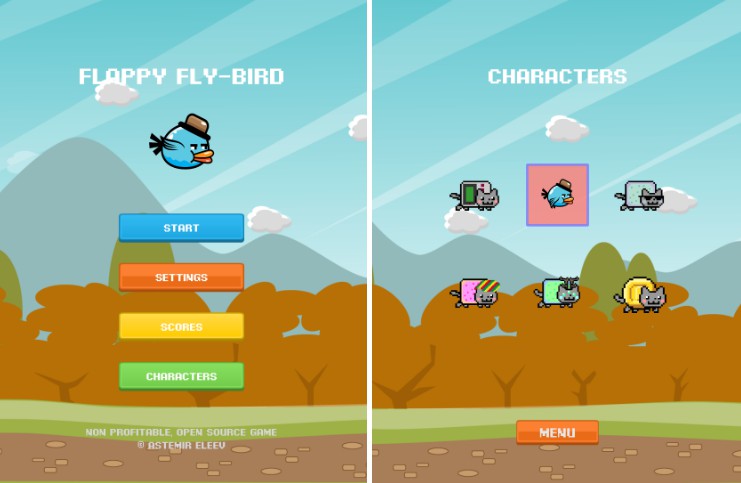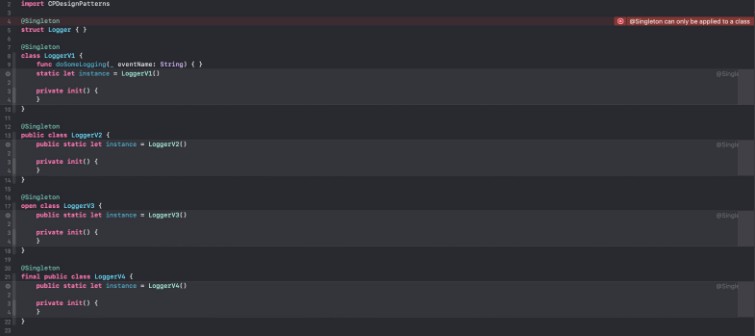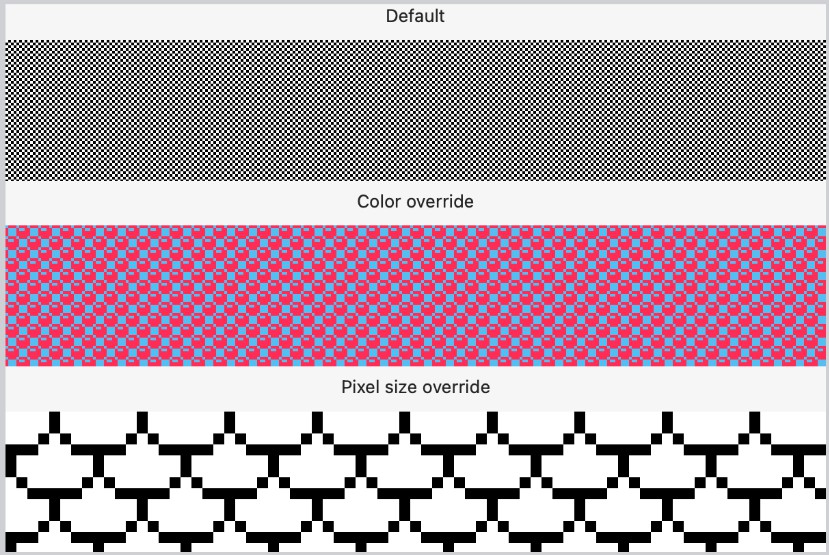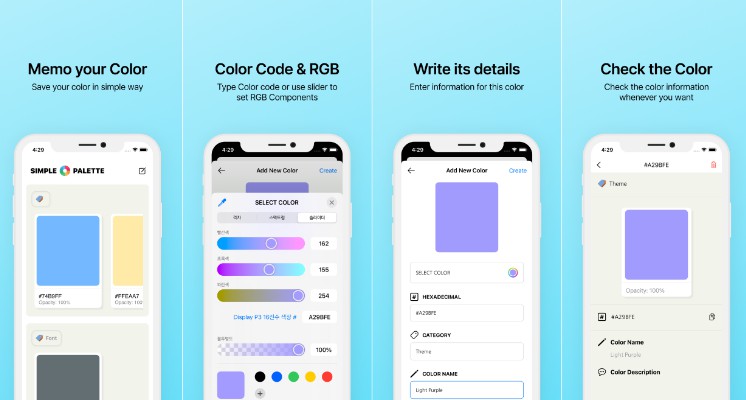Design Patterns implemented in Swift 5.0
A short cheat-sheet with Xcode 10.2 Playground (Design-Patterns.playground.zip).
Behavioral
In software engineering, behavioral design patterns are design patterns that identify common communication patterns between objects and realize these patterns. By doing so, these patterns increase flexibility in carrying out this communication.
Source: wikipedia.org
? Chain Of Responsibility
The chain of responsibility pattern is used to process varied requests, each of which may be dealt with by a different handler.
Example:
protocol Withdrawing {
func withdraw(amount: Int) -> Bool
}
final class MoneyPile: Withdrawing {
let value: Int
var quantity: Int
var next: Withdrawing?
init(value: Int, quantity: Int, next: Withdrawing?) {
self.value = value
self.quantity = quantity
self.next = next
}
func withdraw(amount: Int) -> Bool {
var amount = amount
func canTakeSomeBill(want: Int) -> Bool {
return (want / self.value) > 0
}
var quantity = self.quantity
while canTakeSomeBill(want: amount) {
if quantity == 0 {
break
}
amount -= self.value
quantity -= 1
}
guard amount > 0 else {
return true
}
if let next = self.next {
return next.withdraw(amount: amount)
}
return false
}
}
final class ATM: Withdrawing {
private var hundred: Withdrawing
private var fifty: Withdrawing
private var twenty: Withdrawing
private var ten: Withdrawing
private var startPile: Withdrawing {
return self.hundred
}
init(hundred: Withdrawing,
fifty: Withdrawing,
twenty: Withdrawing,
ten: Withdrawing) {
self.hundred = hundred
self.fifty = fifty
self.twenty = twenty
self.ten = ten
}
func withdraw(amount: Int) -> Bool {
return startPile.withdraw(amount: amount)
}
}
Usage
// Create piles of money and link them together 10 < 20 < 50 < 100.**
let ten = MoneyPile(value: 10, quantity: 6, next: nil)
let twenty = MoneyPile(value: 20, quantity: 2, next: ten)
let fifty = MoneyPile(value: 50, quantity: 2, next: twenty)
let hundred = MoneyPile(value: 100, quantity: 1, next: fifty)
// Build ATM.
var atm = ATM(hundred: hundred, fifty: fifty, twenty: twenty, ten: ten)
atm.withdraw(amount: 310) // Cannot because ATM has only 300
atm.withdraw(amount: 100) // Can withdraw - 1x100
? Command
The command pattern is used to express a request, including the call to be made and all of its required parameters, in a command object. The command may then be executed immediately or held for later use.
Example:
protocol DoorCommand {
func execute() -> String
}
final class OpenCommand: DoorCommand {
let doors:String
required init(doors: String) {
self.doors = doors
}
func execute() -> String {
return "Opened \(doors)"
}
}
final class CloseCommand: DoorCommand {
let doors:String
required init(doors: String) {
self.doors = doors
}
func execute() -> String {
return "Closed \(doors)"
}
}
final class HAL9000DoorsOperations {
let openCommand: DoorCommand
let closeCommand: DoorCommand
init(doors: String) {
self.openCommand = OpenCommand(doors:doors)
self.closeCommand = CloseCommand(doors:doors)
}
func close() -> String {
return closeCommand.execute()
}
func open() -> String {
return openCommand.execute()
}
}
Usage:
let podBayDoors = "Pod Bay Doors"
let doorModule = HAL9000DoorsOperations(doors:podBayDoors)
doorModule.open()
doorModule.close()
? Interpreter
The interpreter pattern is used to evaluate sentences in a language.
Example
protocol IntegerExpression {
func evaluate(_ context: IntegerContext) -> Int
func replace(character: Character, integerExpression: IntegerExpression) -> IntegerExpression
func copied() -> IntegerExpression
}
final class IntegerContext {
private var data: [Character:Int] = [:]
func lookup(name: Character) -> Int {
return self.data[name]!
}
func assign(expression: IntegerVariableExpression, value: Int) {
self.data[expression.name] = value
}
}
final class IntegerVariableExpression: IntegerExpression {
let name: Character
init(name: Character) {
self.name = name
}
func evaluate(_ context: IntegerContext) -> Int {
return context.lookup(name: self.name)
}
func replace(character name: Character, integerExpression: IntegerExpression) -> IntegerExpression {
if name == self.name {
return integerExpression.copied()
} else {
return IntegerVariableExpression(name: self.name)
}
}
func copied() -> IntegerExpression {
return IntegerVariableExpression(name: self.name)
}
}
final class AddExpression: IntegerExpression {
private var operand1: IntegerExpression
private var operand2: IntegerExpression
init(op1: IntegerExpression, op2: IntegerExpression) {
self.operand1 = op1
self.operand2 = op2
}
func evaluate(_ context: IntegerContext) -> Int {
return self.operand1.evaluate(context) + self.operand2.evaluate(context)
}
func replace(character: Character, integerExpression: IntegerExpression) -> IntegerExpression {
return AddExpression(op1: operand1.replace(character: character, integerExpression: integerExpression),
op2: operand2.replace(character: character, integerExpression: integerExpression))
}
func copied() -> IntegerExpression {
return AddExpression(op1: self.operand1, op2: self.operand2)
}
}
Usage
var context = IntegerContext()
var a = IntegerVariableExpression(name: "A")
var b = IntegerVariableExpression(name: "B")
var c = IntegerVariableExpression(name: "C")
var expression = AddExpression(op1: a, op2: AddExpression(op1: b, op2: c)) // a + (b + c)
context.assign(expression: a, value: 2)
context.assign(expression: b, value: 1)
context.assign(expression: c, value: 3)
var result = expression.evaluate(context)
? Iterator
The iterator pattern is used to provide a standard interface for traversing a collection of items in an aggregate object without the need to understand its underlying structure.
Example:
struct Novella {
let name: String
}
struct Novellas {
let novellas: [Novella]
}
struct NovellasIterator: IteratorProtocol {
private var current = 0
private let novellas: [Novella]
init(novellas: [Novella]) {
self.novellas = novellas
}
mutating func next() -> Novella? {
defer { current += 1 }
return novellas.count > current ? novellas[current] : nil
}
}
extension Novellas: Sequence {
func makeIterator() -> NovellasIterator {
return NovellasIterator(novellas: novellas)
}
}
Usage
let greatNovellas = Novellas(novellas: [Novella(name: "The Mist")] )
for novella in greatNovellas {
print("I've read: \(novella)")
}
? Mediator
The mediator pattern is used to reduce coupling between classes that communicate with each other. Instead of classes communicating directly, and thus requiring knowledge of their implementation, the classes send messages via a mediator object.
Example
protocol Receiver {
associatedtype MessageType
func receive(message: MessageType)
}
protocol Sender {
associatedtype MessageType
associatedtype ReceiverType: Receiver
var recipients: [ReceiverType] { get }
func send(message: MessageType)
}
struct Programmer: Receiver {
let name: String
init(name: String) {
self.name = name
}
func receive(message: String) {
print("\(name) received: \(message)")
}
}
final class MessageMediator: Sender {
internal var recipients: [Programmer] = []
func add(recipient: Programmer) {
recipients.append(recipient)
}
func send(message: String) {
for recipient in recipients {
recipient.receive(message: message)
}
}
}
Usage
func spamMonster(message: String, worker: MessageMediator) {
worker.send(message: message)
}
let messagesMediator = MessageMediator()
let user0 = Programmer(name: "Linus Torvalds")
let user1 = Programmer(name: "Avadis 'Avie' Tevanian")
messagesMediator.add(recipient: user0)
messagesMediator.add(recipient: user1)
spamMonster(message: "I'd Like to Add you to My Professional Network", worker: messagesMediator)
? Memento
The memento pattern is used to capture the current state of an object and store it in such a manner that it can be restored at a later time without breaking the rules of encapsulation.
Example
typealias Memento = [String: String]
Originator
protocol MementoConvertible {
var memento: Memento { get }
init?(memento: Memento)
}
struct GameState: MementoConvertible {
private enum Keys {
static let chapter = "com.valve.halflife.chapter"
static let weapon = "com.valve.halflife.weapon"
}
var chapter: String
var weapon: String
init(chapter: String, weapon: String) {
self.chapter = chapter
self.weapon = weapon
}
init?(memento: Memento) {
guard let mementoChapter = memento[Keys.chapter],
let mementoWeapon = memento[Keys.weapon] else {
return nil
}
chapter = mementoChapter
weapon = mementoWeapon
}
var memento: Memento {
return [ Keys.chapter: chapter, Keys.weapon: weapon ]
}
}
Caretaker
enum CheckPoint {
private static let defaults = UserDefaults.standard
static func save(_ state: MementoConvertible, saveName: String) {
defaults.set(state.memento, forKey: saveName)
defaults.synchronize()
}
static func restore(saveName: String) -> Any? {
return defaults.object(forKey: saveName)
}
}
Usage
var gameState = GameState(chapter: "Black Mesa Inbound", weapon: "Crowbar")
gameState.chapter = "Anomalous Materials"
gameState.weapon = "Glock 17"
CheckPoint.save(gameState, saveName: "gameState1")
gameState.chapter = "Unforeseen Consequences"
gameState.weapon = "MP5"
CheckPoint.save(gameState, saveName: "gameState2")
gameState.chapter = "Office Complex"
gameState.weapon = "Crossbow"
CheckPoint.save(gameState, saveName: "gameState3")
if let memento = CheckPoint.restore(saveName: "gameState1") as? Memento {
let finalState = GameState(memento: memento)
dump(finalState)
}
? Observer
The observer pattern is used to allow an object to publish changes to its state.
Other objects subscribe to be immediately notified of any changes.
Example
protocol PropertyObserver : class {
func willChange(propertyName: String, newPropertyValue: Any?)
func didChange(propertyName: String, oldPropertyValue: Any?)
}
final class TestChambers {
weak var observer:PropertyObserver?
private let testChamberNumberName = "testChamberNumber"
var testChamberNumber: Int = 0 {
willSet(newValue) {
observer?.willChange(propertyName: testChamberNumberName, newPropertyValue: newValue)
}
didSet {
observer?.didChange(propertyName: testChamberNumberName, oldPropertyValue: oldValue)
}
}
}
final class Observer : PropertyObserver {
func willChange(propertyName: String, newPropertyValue: Any?) {
if newPropertyValue as? Int == 1 {
print("Okay. Look. We both said a lot of things that you're going to regret.")
}
}
func didChange(propertyName: String, oldPropertyValue: Any?) {
if oldPropertyValue as? Int == 0 {
print("Sorry about the mess. I've really let the place go since you killed me.")
}
}
}
Usage
var observerInstance = Observer()
var testChambers = TestChambers()
testChambers.observer = observerInstance
testChambers.testChamberNumber += 1
? State
The state pattern is used to alter the behaviour of an object as its internal state changes.
The pattern allows the class for an object to apparently change at run-time.
Example
final class Context {
private var state: State = UnauthorizedState()
var isAuthorized: Bool {
get { return state.isAuthorized(context: self) }
}
var userId: String? {
get { return state.userId(context: self) }
}
func changeStateToAuthorized(userId: String) {
state = AuthorizedState(userId: userId)
}
func changeStateToUnauthorized() {
state = UnauthorizedState()
}
}
protocol State {
func isAuthorized(context: Context) -> Bool
func userId(context: Context) -> String?
}
class UnauthorizedState: State {
func isAuthorized(context: Context) -> Bool { return false }
func userId(context: Context) -> String? { return nil }
}
class AuthorizedState: State {
let userId: String
init(userId: String) { self.userId = userId }
func isAuthorized(context: Context) -> Bool { return true }
func userId(context: Context) -> String? { return userId }
}
Usage
let userContext = Context()
(userContext.isAuthorized, userContext.userId)
userContext.changeStateToAuthorized(userId: "admin")
(userContext.isAuthorized, userContext.userId) // now logged in as "admin"
userContext.changeStateToUnauthorized()
(userContext.isAuthorized, userContext.userId)
? Strategy
The strategy pattern is used to create an interchangeable family of algorithms from which the required process is chosen at run-time.
Example
struct TestSubject {
let pupilDiameter: Double
let blushResponse: Double
let isOrganic: Bool
}
protocol RealnessTesting: AnyObject {
func testRealness(_ testSubject: TestSubject) -> Bool
}
final class VoightKampffTest: RealnessTesting {
func testRealness(_ testSubject: TestSubject) -> Bool {
return testSubject.pupilDiameter < 30.0 || testSubject.blushResponse == 0.0
}
}
final class GeneticTest: RealnessTesting {
func testRealness(_ testSubject: TestSubject) -> Bool {
return testSubject.isOrganic
}
}
final class BladeRunner {
private let strategy: RealnessTesting
init(test: RealnessTesting) {
self.strategy = test
}
func testIfAndroid(_ testSubject: TestSubject) -> Bool {
return !strategy.testRealness(testSubject)
}
}
Usage
let rachel = TestSubject(pupilDiameter: 30.2,
blushResponse: 0.3,
isOrganic: false)
// Deckard is using a traditional test
let deckard = BladeRunner(test: VoightKampffTest())
let isRachelAndroid = deckard.testIfAndroid(rachel)
// Gaff is using a very precise method
let gaff = BladeRunner(test: GeneticTest())
let isDeckardAndroid = gaff.testIfAndroid(rachel)
? Template Method
The template method pattern defines the steps of an algorithm and allows the redefinition of one or more of these steps. In this way, the template method protects the algorithm, the order of execution and provides abstract methods that can be implemented by concrete types.
Example
protocol Garden {
func prepareSoil()
func plantSeeds()
func waterPlants()
func prepareGarden()
}
extension Garden {
func prepareGarden() {
prepareSoil()
plantSeeds()
waterPlants()
}
}
final class RoseGarden: Garden {
func prepare() {
prepareGarden()
}
func prepareSoil() {
print ("prepare soil for rose garden")
}
func plantSeeds() {
print ("plant seeds for rose garden")
}
func waterPlants() {
print ("water the rose garden")
}
}
Usage
let roseGarden = RoseGarden()
roseGarden.prepare()
? Visitor
The visitor pattern is used to separate a relatively complex set of structured data classes from the functionality that may be performed upon the data that they hold.
Example
protocol PlanetVisitor {
func visit(planet: PlanetAlderaan)
func visit(planet: PlanetCoruscant)
func visit(planet: PlanetTatooine)
func visit(planet: MoonJedha)
}
protocol Planet {
func accept(visitor: PlanetVisitor)
}
final class MoonJedha: Planet {
func accept(visitor: PlanetVisitor) { visitor.visit(planet: self) }
}
final class PlanetAlderaan: Planet {
func accept(visitor: PlanetVisitor) { visitor.visit(planet: self) }
}
final class PlanetCoruscant: Planet {
func accept(visitor: PlanetVisitor) { visitor.visit(planet: self) }
}
final class PlanetTatooine: Planet {
func accept(visitor: PlanetVisitor) { visitor.visit(planet: self) }
}
final class NameVisitor: PlanetVisitor {
var name = ""
func visit(planet: PlanetAlderaan) { name = "Alderaan" }
func visit(planet: PlanetCoruscant) { name = "Coruscant" }
func visit(planet: PlanetTatooine) { name = "Tatooine" }
func visit(planet: MoonJedha) { name = "Jedha" }
}
Usage
let planets: [Planet] = [PlanetAlderaan(), PlanetCoruscant(), PlanetTatooine(), MoonJedha()]
let names = planets.map { (planet: Planet) -> String in
let visitor = NameVisitor()
planet.accept(visitor: visitor)
return visitor.name
}
names
Creational
In software engineering, creational design patterns are design patterns that deal with object creation mechanisms, trying to create objects in a manner suitable to the situation. The basic form of object creation could result in design problems or added complexity to the design. Creational design patterns solve this problem by somehow controlling this object creation.
Source: wikipedia.org
? Abstract Factory
The abstract factory pattern is used to provide a client with a set of related or dependant objects.
The "family" of objects created by the factory are determined at run-time.
Example
Protocols
protocol BurgerDescribing {
var ingredients: [String] { get }
}
struct CheeseBurger: BurgerDescribing {
let ingredients: [String]
}
protocol BurgerMaking {
func make() -> BurgerDescribing
}
// Number implementations with factory methods
final class BigKahunaBurger: BurgerMaking {
func make() -> BurgerDescribing {
return CheeseBurger(ingredients: ["Cheese", "Burger", "Lettuce", "Tomato"])
}
}
final class JackInTheBox: BurgerMaking {
func make() -> BurgerDescribing {
return CheeseBurger(ingredients: ["Cheese", "Burger", "Tomato", "Onions"])
}
}
Abstract factory
enum BurgerFactoryType: BurgerMaking {
case bigKahuna
case jackInTheBox
func make() -> BurgerDescribing {
switch self {
case .bigKahuna:
return BigKahunaBurger().make()
case .jackInTheBox:
return JackInTheBox().make()
}
}
}
Usage
let bigKahuna = BurgerFactoryType.bigKahuna.make()
let jackInTheBox = BurgerFactoryType.jackInTheBox.make()
? Builder
The builder pattern is used to create complex objects with constituent parts that must be created in the same order or using a specific algorithm.
An external class controls the construction algorithm.
Example
final class DeathStarBuilder {
var x: Double?
var y: Double?
var z: Double?
typealias BuilderClosure = (DeathStarBuilder) -> ()
init(buildClosure: BuilderClosure) {
buildClosure(self)
}
}
struct DeathStar : CustomStringConvertible {
let x: Double
let y: Double
let z: Double
init?(builder: DeathStarBuilder) {
if let x = builder.x, let y = builder.y, let z = builder.z {
self.x = x
self.y = y
self.z = z
} else {
return nil
}
}
var description:String {
return "Death Star at (x:\(x) y:\(y) z:\(z))"
}
}
Usage
let empire = DeathStarBuilder { builder in
builder.x = 0.1
builder.y = 0.2
builder.z = 0.3
}
let deathStar = DeathStar(builder:empire)
? Factory Method
The factory pattern is used to replace class constructors, abstracting the process of object generation so that the type of the object instantiated can be determined at run-time.
Example
protocol CurrencyDescribing {
var symbol: String { get }
var code: String { get }
}
final class Euro: CurrencyDescribing {
var symbol: String {
return "€"
}
var code: String {
return "EUR"
}
}
final class UnitedStatesDolar: CurrencyDescribing {
var symbol: String {
return "$"
}
var code: String {
return "USD"
}
}
enum Country {
case unitedStates
case spain
case uk
case greece
}
enum CurrencyFactory {
static func currency(for country: Country) -> CurrencyDescribing? {
switch country {
case .spain, .greece:
return Euro()
case .unitedStates:
return UnitedStatesDolar()
default:
return nil
}
}
}
Usage
let noCurrencyCode = "No Currency Code Available"
CurrencyFactory.currency(for: .greece)?.code ?? noCurrencyCode
CurrencyFactory.currency(for: .spain)?.code ?? noCurrencyCode
CurrencyFactory.currency(for: .unitedStates)?.code ?? noCurrencyCode
CurrencyFactory.currency(for: .uk)?.code ?? noCurrencyCode
? Monostate
The monostate pattern is another way to achieve singularity. It works through a completely different mechanism, it enforces the behavior of singularity without imposing structural constraints.
So in that case, monostate saves the state as static instead of the entire instance as a singleton.
SINGLETON and MONOSTATE - Robert C. Martin
Example:
class Settings {
enum Theme {
case `default`
case old
case new
}
private static var theme: Theme?
var currentTheme: Theme {
get { Settings.theme ?? .default }
set(newTheme) { Settings.theme = newTheme }
}
}
Usage:
import SwiftUI
// When change the theme
let settings = Settings() // Starts using theme .old
settings.currentTheme = .new // Change theme to .new
// On screen 1
let screenColor: Color = Settings().currentTheme == .old ? .gray : .white
// On screen 2
let screenTitle: String = Settings().currentTheme == .old ? "Itunes Connect" : "App Store Connect"
? Prototype
The prototype pattern is used to instantiate a new object by copying all of the properties of an existing object, creating an independent clone.
This practise is particularly useful when the construction of a new object is inefficient.
Example
class MoonWorker {
let name: String
var health: Int = 100
init(name: String) {
self.name = name
}
func clone() -> MoonWorker {
return MoonWorker(name: name)
}
}
Usage
let prototype = MoonWorker(name: "Sam Bell")
var bell1 = prototype.clone()
bell1.health = 12
var bell2 = prototype.clone()
bell2.health = 23
var bell3 = prototype.clone()
bell3.health = 0
? Singleton
The singleton pattern ensures that only one object of a particular class is ever created.
All further references to objects of the singleton class refer to the same underlying instance.
There are very few applications, do not overuse this pattern!
Example:
final class ElonMusk {
static let shared = ElonMusk()
private init() {
// Private initialization to ensure just one instance is created.
}
}
Usage:
let elon = ElonMusk.shared // There is only one Elon Musk folks.
Structural
In software engineering, structural design patterns are design patterns that ease the design by identifying a simple way to realize relationships between entities.
Source: wikipedia.org
? Adapter
The adapter pattern is used to provide a link between two otherwise incompatible types by wrapping the "adaptee" with a class that supports the interface required by the client.
Example
protocol NewDeathStarSuperLaserAiming {
var angleV: Double { get }
var angleH: Double { get }
}
Adaptee
struct OldDeathStarSuperlaserTarget {
let angleHorizontal: Float
let angleVertical: Float
init(angleHorizontal: Float, angleVertical: Float) {
self.angleHorizontal = angleHorizontal
self.angleVertical = angleVertical
}
}
Adapter
struct NewDeathStarSuperlaserTarget: NewDeathStarSuperLaserAiming {
private let target: OldDeathStarSuperlaserTarget
var angleV: Double {
return Double(target.angleVertical)
}
var angleH: Double {
return Double(target.angleHorizontal)
}
init(_ target: OldDeathStarSuperlaserTarget) {
self.target = target
}
}
Usage
let target = OldDeathStarSuperlaserTarget(angleHorizontal: 14.0, angleVertical: 12.0)
let newFormat = NewDeathStarSuperlaserTarget(target)
newFormat.angleH
newFormat.angleV
? Bridge
The bridge pattern is used to separate the abstract elements of a class from the implementation details, providing the means to replace the implementation details without modifying the abstraction.
Example
protocol Switch {
var appliance: Appliance { get set }
func turnOn()
}
protocol Appliance {
func run()
}
final class RemoteControl: Switch {
var appliance: Appliance
func turnOn() {
self.appliance.run()
}
init(appliance: Appliance) {
self.appliance = appliance
}
}
final class TV: Appliance {
func run() {
print("tv turned on");
}
}
final class VacuumCleaner: Appliance {
func run() {
print("vacuum cleaner turned on")
}
}
Usage
let tvRemoteControl = RemoteControl(appliance: TV())
tvRemoteControl.turnOn()
let fancyVacuumCleanerRemoteControl = RemoteControl(appliance: VacuumCleaner())
fancyVacuumCleanerRemoteControl.turnOn()
? Composite
The composite pattern is used to create hierarchical, recursive tree structures of related objects where any element of the structure may be accessed and utilised in a standard manner.
Example
Component
protocol Shape {
func draw(fillColor: String)
}
Leafs
final class Square: Shape {
func draw(fillColor: String) {
print("Drawing a Square with color \(fillColor)")
}
}
final class Circle: Shape {
func draw(fillColor: String) {
print("Drawing a circle with color \(fillColor)")
}
}
Composite
final class Whiteboard: Shape {
private lazy var shapes = [Shape]()
init(_ shapes: Shape...) {
self.shapes = shapes
}
func draw(fillColor: String) {
for shape in self.shapes {
shape.draw(fillColor: fillColor)
}
}
}
Usage:
var whiteboard = Whiteboard(Circle(), Square())
whiteboard.draw(fillColor: "Red")
? Decorator
The decorator pattern is used to extend or alter the functionality of objects at run- time by wrapping them in an object of a decorator class.
This provides a flexible alternative to using inheritance to modify behaviour.
Example
protocol CostHaving {
var cost: Double { get }
}
protocol IngredientsHaving {
var ingredients: [String] { get }
}
typealias BeverageDataHaving = CostHaving & IngredientsHaving
struct SimpleCoffee: BeverageDataHaving {
let cost: Double = 1.0
let ingredients = ["Water", "Coffee"]
}
protocol BeverageHaving: BeverageDataHaving {
var beverage: BeverageDataHaving { get }
}
struct Milk: BeverageHaving {
let beverage: BeverageDataHaving
var cost: Double {
return beverage.cost + 0.5
}
var ingredients: [String] {
return beverage.ingredients + ["Milk"]
}
}
struct WhipCoffee: BeverageHaving {
let beverage: BeverageDataHaving
var cost: Double {
return beverage.cost + 0.5
}
var ingredients: [String] {
return beverage.ingredients + ["Whip"]
}
}
Usage:
var someCoffee: BeverageDataHaving = SimpleCoffee()
print("Cost: \(someCoffee.cost); Ingredients: \(someCoffee.ingredients)")
someCoffee = Milk(beverage: someCoffee)
print("Cost: \(someCoffee.cost); Ingredients: \(someCoffee.ingredients)")
someCoffee = WhipCoffee(beverage: someCoffee)
print("Cost: \(someCoffee.cost); Ingredients: \(someCoffee.ingredients)")
? Façade
The facade pattern is used to define a simplified interface to a more complex subsystem.
Example
final class Defaults {
private let defaults: UserDefaults
init(defaults: UserDefaults = .standard) {
self.defaults = defaults
}
subscript(key: String) -> String? {
get {
return defaults.string(forKey: key)
}
set {
defaults.set(newValue, forKey: key)
}
}
}
Usage
let storage = Defaults()
// Store
storage["Bishop"] = "Disconnect me. I’d rather be nothing"
// Read
storage["Bishop"]
? Flyweight
The flyweight pattern is used to minimize memory usage or computational expenses by sharing as much as possible with other similar objects.
Example
// Instances of SpecialityCoffee will be the Flyweights
struct SpecialityCoffee {
let origin: String
}
protocol CoffeeSearching {
func search(origin: String) -> SpecialityCoffee?
}
// Menu acts as a factory and cache for SpecialityCoffee flyweight objects
final class Menu: CoffeeSearching {
private var coffeeAvailable: [String: SpecialityCoffee] = [:]
func search(origin: String) -> SpecialityCoffee? {
if coffeeAvailable.index(forKey: origin) == nil {
coffeeAvailable[origin] = SpecialityCoffee(origin: origin)
}
return coffeeAvailable[origin]
}
}
final class CoffeeShop {
private var orders: [Int: SpecialityCoffee] = [:]
private let menu: CoffeeSearching
init(menu: CoffeeSearching) {
self.menu = menu
}
func takeOrder(origin: String, table: Int) {
orders[table] = menu.search(origin: origin)
}
func serve() {
for (table, origin) in orders {
print("Serving \(origin) to table \(table)")
}
}
}
Usage
let coffeeShop = CoffeeShop(menu: Menu())
coffeeShop.takeOrder(origin: "Yirgacheffe, Ethiopia", table: 1)
coffeeShop.takeOrder(origin: "Buziraguhindwa, Burundi", table: 3)
coffeeShop.serve()
☔ Protection Proxy
The proxy pattern is used to provide a surrogate or placeholder object, which references an underlying object.
Protection proxy is restricting access.
Example
protocol DoorOpening {
func open(doors: String) -> String
}
final class HAL9000: DoorOpening {
func open(doors: String) -> String {
return ("HAL9000: Affirmative, Dave. I read you. Opened \(doors).")
}
}
final class CurrentComputer: DoorOpening {
private var computer: HAL9000!
func authenticate(password: String) -> Bool {
guard password == "pass" else {
return false
}
computer = HAL9000()
return true
}
func open(doors: String) -> String {
guard computer != nil else {
return "Access Denied. I'm afraid I can't do that."
}
return computer.open(doors: doors)
}
}
Usage
let computer = CurrentComputer()
let podBay = "Pod Bay Doors"
computer.open(doors: podBay)
computer.authenticate(password: "pass")
computer.open(doors: podBay)
? Virtual Proxy
The proxy pattern is used to provide a surrogate or placeholder object, which references an underlying object.
Virtual proxy is used for loading object on demand.
Example
protocol HEVSuitMedicalAid {
func administerMorphine() -> String
}
final class HEVSuit: HEVSuitMedicalAid {
func administerMorphine() -> String {
return "Morphine administered."
}
}
final class HEVSuitHumanInterface: HEVSuitMedicalAid {
lazy private var physicalSuit: HEVSuit = HEVSuit()
func administerMorphine() -> String {
return physicalSuit.administerMorphine()
}
}
Usage
let humanInterface = HEVSuitHumanInterface()
humanInterface.administerMorphine()



